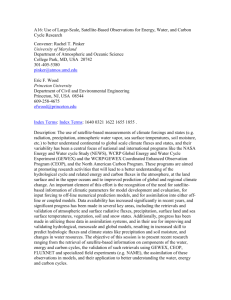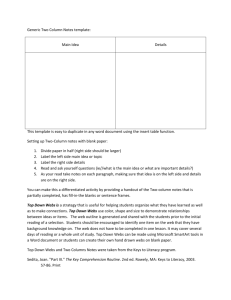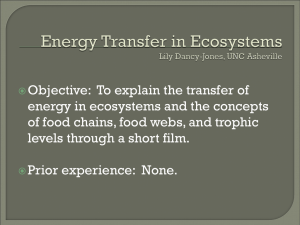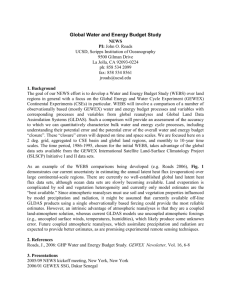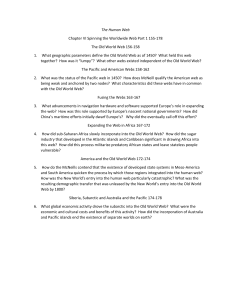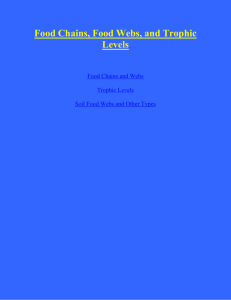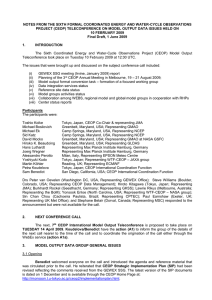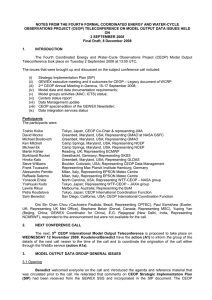Please input for CEOP/WEBS
advertisement
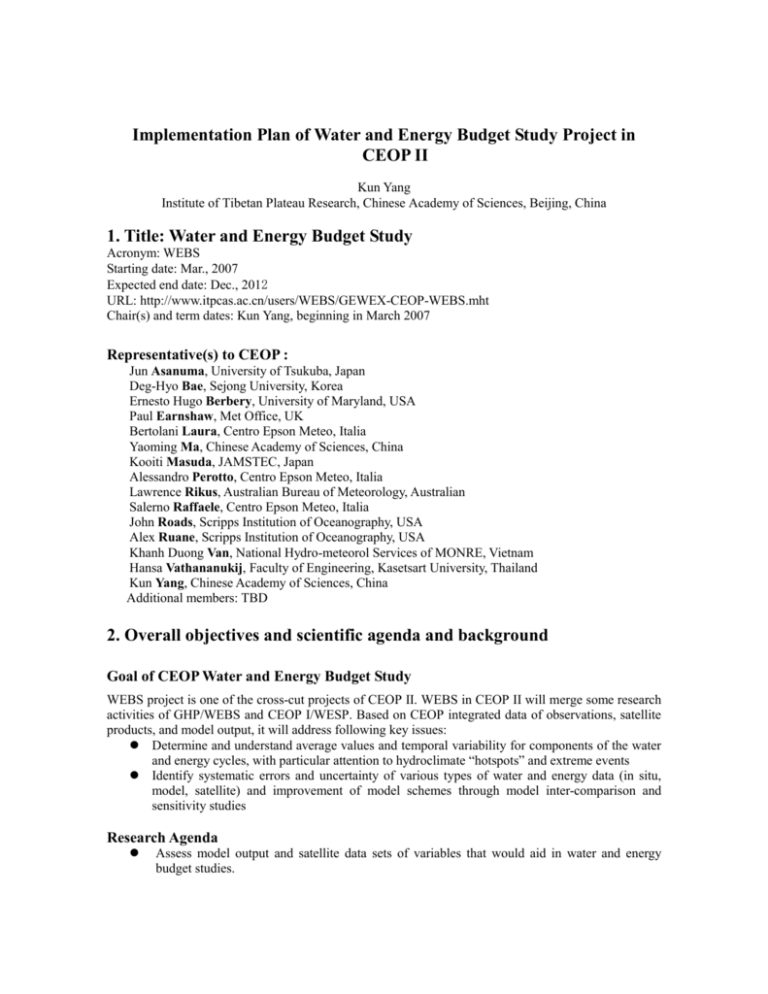
Implementation Plan of Water and Energy Budget Study Project in CEOP II Kun Yang Institute of Tibetan Plateau Research, Chinese Academy of Sciences, Beijing, China 1. Title: Water and Energy Budget Study Acronym: WEBS Starting date: Mar., 2007 Expected end date: Dec., 2012 URL: http://www.itpcas.ac.cn/users/WEBS/GEWEX-CEOP-WEBS.mht Chair(s) and term dates: Kun Yang, beginning in March 2007 Representative(s) to CEOP : Jun Asanuma, University of Tsukuba, Japan Deg-Hyo Bae, Sejong University, Korea Ernesto Hugo Berbery, University of Maryland, USA Paul Earnshaw, Met Office, UK Bertolani Laura, Centro Epson Meteo, Italia Yaoming Ma, Chinese Academy of Sciences, China Kooiti Masuda, JAMSTEC, Japan Alessandro Perotto, Centro Epson Meteo, Italia Lawrence Rikus, Australian Bureau of Meteorology, Australian Salerno Raffaele, Centro Epson Meteo, Italia John Roads, Scripps Institution of Oceanography, USA Alex Ruane, Scripps Institution of Oceanography, USA Khanh Duong Van, National Hydro-meteorol Services of MONRE, Vietnam Hansa Vathananukij, Faculty of Engineering, Kasetsart University, Thailand Kun Yang, Chinese Academy of Sciences, China Additional members: TBD 2. Overall objectives and scientific agenda and background Goal of CEOP Water and Energy Budget Study WEBS project is one of the cross-cut projects of CEOP II. WEBS in CEOP II will merge some research activities of GHP/WEBS and CEOP I/WESP. Based on CEOP integrated data of observations, satellite products, and model output, it will address following key issues: Determine and understand average values and temporal variability for components of the water and energy cycles, with particular attention to hydroclimate “hotspots” and extreme events Identify systematic errors and uncertainty of various types of water and energy data (in situ, model, satellite) and improvement of model schemes through model inter-comparison and sensitivity studies Research Agenda Assess model output and satellite data sets of variables that would aid in water and energy budget studies. Explore Exchange among surface, atmospheric, and full-column water and energy budget profiles. Improve estimation of water and energy budgets in hydroclimate “hotspots” such as Tibet and semi-arid regions, where there are large component interactions in the water and energy cycles. Understand water and energy budget processes and develop schemes for cold and high-elevation regions. Investigate water and energy budget for extreme events and large-scale low-frequency climate events (NAO, ENSO, PDO) and the role of land-atmosphere interactions in these events. Implement Strategies Collection of in situ data, model output, and satellite data and products. Data inter-comparison study to identify model deficiencies in simulating water and energy budget and to evaluate satellite products needed for water and energy budget study. Application of land data assimilation to produce multi-years soil moisture and land flux for regions with large component interactions (so-called high-impact regions, such as Tibet and semi-arid regions). Evaluation of exchange and variability among surface, atmospheric, and full-column water and energy budget profiles in high-impact regions. Analyze relationships between water and energy budget anomalies in high-impact regions and relevant extreme events. Evaluate global water cycle using regional model inter-comparison and parameterization sensitivity experiments to improve parameterization schemes and understanding diurnal ~ inter-annual variability Identify and focus on regions where water cycle simulation has trouble Background Water and energy budgets on the surface and in the atmosphere are the key processes of the climate system, which in turn drive/affect other processes in the system. The water and energy budgets are not only dependent on a variety of time scale (from diurnal and seasonal variations to inter-annual and decadal variability), but also characterized by regional differences and inter-connections. GEWEX Phase I Results have addressed regional variability of water and energy components, the importance of land surface parameterization for precipitation forecast, and the importance of Continental-Scale Experiments in closure of the regional water and energy budgets. The CEOP has developed a function to integrate in situ data, model output, satellite and a function to exchange and disseminate observational data and information including data management. It provides an art-of-the-state opportunity to further address these issues, as is the major scope of CEOP Water and Energy Budget Studies (WEBS). The WEBS project was first initiated by GEWEX/GHP to develop the “best available water and energy budgets”, for the global land regions associated with the GEWEX Continental-Scale Experiments (CSEs). The CEOP WEBS element will merge research activities of GHP WEBS with some activities of the old CEOP WESP (such as model inter-comparisons). Based on CEOP integrated data of observations, satellite products, and model output, it will address following key issues related to data quality, model deficiencies and sciences: How to quantify data accuracy, uncertainties, and discrepancies of energy and water components, particularly for RHP regions? There are many data sources for each hydrological/energy component. Which is superior to others, if any? How to integrate in situ, model and satellite to develop the “best available water and energy budgets”, for the global land regions associated with RHP? With current available data, how to identify deficiencies of model parameterizations and satellite algorithms? How to characterize differences and inter-connections of regional water and energy budgets, and their temporal variability, particularly for hydroclimate “hotspots”, extreme events as well as low-frequency climate events? What is the role of land-atmosphere interactions for hydroclimate “hotspots”, extreme events as well as low-frequency climate events? Water and energy budget is a broad topic in GEWEX research community. WEBS defines its scope to be an analysis and assessment project (though it also covers modeling and data assimilation) and to address regional water and energy budget more than global one. 3. Major results so far (bullets) Identified an altitude-dependent systematic error in GEWEX-SRB solar radiation algorithm. Conducted an initial multi-model multi-site inter-comparisons based on CEOP data to identify model systematic errors in simulating radiation, energy and water budget at different scales Developed a microwave land data assimilation, which shows significant improvements in modeling soil moisture and surface energy budget Compared the diurnal cycle of water and energy (both surface and integrated column) over the continental United States from three analyses, showing consistent phases while varying amplitude. Carried out inter-comparison and sensitivity studies both on global and mesoscale models, with a particular attention to the hydroclimate “hotspots”, especially the Alps and the Himalayan region, with a direct experience in simulating monsoonal circulation and monsoonal related precipitation in the Tibetan plateau Developed parameterization scheme to upscale surface energy budget from field observations. Key publications: Bertolani, L., and R. Salerno, 2006a: Verification of numerical model forecasts of precipitation and satellite-derived rainfall estimates over the Indian region – Monsoon 2004. Proc. “Mountain witnesses of global changes. Research in the Himalaya and Karakoram: SHARE-Asia Project” Conference, Rome (Italy), 16-17 November 2005. Bertolani, L., R. Salerno and E. Musso, 2006b: Verification of EMC-GCM forecasts of precipitation and comparison with satellite-derived rainfall estimates (oral presentation). The 1st Pan-GEWEX Meeting, Frascati (Italy), 9-13 October 2006. Bertolani, L., A. Perotto, R. Salerno and E. Musso, 2007: Verification and Intercomparison of NWP global models against CEOP I reference site data, (poster presentation). The 6th CEOP Implementation Planning Meeting, Washington DC (USA), 12 -17 March 2007. Ma et al., 2007: Estimation of the Regional Evaporative Fraction over the Tibetan Plateau Area by Using Landsat-7 ETM data and the Field Observations, J. Meteor. Soc. Japan, 85A, 295-309. Ruane, A. C. and J. O. Roads, 2007: The diurnal cycle of water and energy over the Continental United States from three reanalyses, J. Meteor. Soc. Japan, 85A, 117-143. Yang, K. et al., 2006: An assessment of satellite surface radiation products for highlands with Tibet instrumental data, GRL, 33, L22403, doi:10.1029/2006GL027640. Yang, K. et al., 2007a: Initial CEOP-based Review of the Prediction Skill of Operational General Circulation Models and Land Surface Models, J. Meteor. Soc. Japan, 85A, 99-116. Yang, K. et al., 2007b: Auto-calibration System developed to Assimilate AMSR-E data into a Land Surface Model for Estimating the Soil Moisture and Surface Energy Budget, J. Meteor. Soc. Japan, 85A, 229-242. 4. Status in 2007 Planning activities: Determined project representatives by communicating research groups Synthesized major research activities Made science implementation planning Research activities: CEOP data inter-comparison study Development and validation of a land data assimilation system. Evaluation of satellite products of radiation needed for WEBS Evaluation of global water cycle using regional model inter-comparison and parameterization sensitivity experiments Land-surface, convection, and boundary layer schemes Diurnal ~ Interannual variability 5. Plans for next 2-3 years Complete products of multi-years soil moisture and land fluxes for regions with large component interactions (such as Tibet and semi-arid regions) using a validated land data assimilation system. Complete evaluation of exchange and variability among surface, atmospheric, and full-column water and energy budget profiles in high-impact regions. Explore relationships between water and energy budget anomalies in high-impact regions and relevant extreme events. Evaluate global water cycle using regional model inter-comparison and parameterization sensitivity experiments to improve Land-surface, convection, and boundary layer schemes Diurnal ~ Interannual variability Identify regions where water cycle simulation has trouble by collaborating with semi-arid, high-elevation cold region projects 6. Interactions with other Groups WEBS is a data-based cross-cut project concerning many projects of CEOP. Its success needs strong collaboration from RHPs, NWP centers, space agencies, data integration centers. To answer concerned scientific issues, WEBS group will work jointly with other groups (CEOP subprojects, GRP-SRB and GMPP-follow-on) on some topics for improving quantitative knowledge on water and energy budgets from local short-term to global long-term (multi-decadal) scales. The output of WEBS land data assimilation needs validations using in situ data from RHPs. Improvements of parameterization schemes depends on the progress of extreme events, high-elevation, cold regions, and semiarid regions projects. The products of land data assimilation will be provided to other projects for analyzing global/regional water and energy cycle. 7. Planned and potential contributions to the GEWEX roadmap GEWEX Objective 1: Evaluate satellite products of precipitation and surface radiation and energy budget with reference data Produce Tibet multi-year water and energy budget data sets by combining in situ, model output, satellite data GEWEX Objective 2: Evaluate global water cycle using model intercomparison and parameterization sensitivity experiments Land-surface, convective, and boundary layer schemes Diurnal and interannual variability Identify and focus on regions where water cycle simulation has trouble Overlap with semi-arid and cold region studies Identify remotely-sensed datasets that will be useful Regional hydroclimate hotspot studies in Tibet, including surface and atmospheric water and energy budget, its relation with extreme events in East Asia GEWEX Objective 3: Apply CEOP-based inter-comparison study and identify model deficiencies in simulating diurnal, seasonal, and annual precipitation pattern and water and energy budget using CEOP phase 1; GEWEX Objective 4: Based on data inter-comparisons, recommend model and satellite data for hydro-meteorological applications 8. Planned interactions with other research, application and user communities WEBS will provide output of soil moisture and land fluxes for researchers of Asian Monsoon Year (AMY) and Monsoon Asia Integrated Regional Study (MAIRS) projects. The latter two, in turn, will help explore the roles of land-atmosphere interactions in aridity of semi-arid regions and extreme events.



